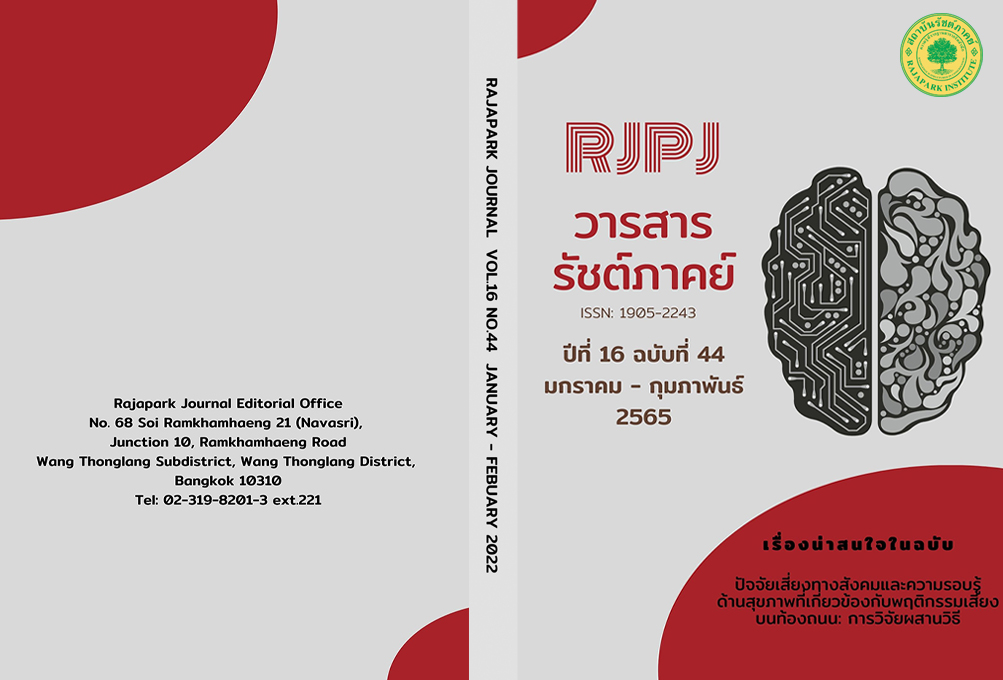Social Risk Factors and Health Literacy Related to Road Risk Behaviors: Mixed Methods Research
Main Article Content
Abstract
The objectives of this paper were to investigate and identify social risk factors associated with road risk behavior and to study causal factors of social risk and health literacy associated with road risk behavior, by using mixed methods research which was done by qualitative and quantitative methods. For the qualitative study, the data were collected by interview and focus group discussion with users and experts who have experience of using road vehicles, and experts who were qualified in behavioral science or psychology. The data were analyzed by using the content analysis technique. For the quantitative study, the data were collected with 1,284 road users in Bangkok and vicinity, then analyzed by using descriptive statistics, path analysis, and analysis of variance (ANOVA). The results showed that social risk associated with road risk behaviors comprised of both individual and environmental factors. The empirical data conformed with the causal risk behavior model by the examination of Chi-square which was 5.61. Moreover, the finding showed that health literacy and driving duration were directly influenced by risk and challenge seeking. These two factors can predict health literacy by 19%. Road risk behavior was directly influenced by health literacy, driving duration, risk and challenge seeking, and modeling of road risk. These four factors can predict road risk behavior by 84%. From the findings of the study, government and other related sectors can support improvement and prevention on individual factors as well as changing policies and environmental risk factors.
Article Details

This work is licensed under a Creative Commons Attribution-NonCommercial-NoDerivatives 4.0 International License.
Views and opinions appearing in the Journal it is the responsibility of the author of the article, and does not constitute the view and responsibility of the editorial team.
References
Bandura, A. (1977). Social Learning Theory. New Jersey: Prentice-Hall.
Biggins, O. (2014). Campaigns for Solving Motorcycle Drunk Driving Behavior of Adolescents. Journal of Communication and Innovation NIDA. 1(1). 69-84.
Bronfenbrenner, U. (2005). Making Human Beings Human: Bioecological Perspectives on Human Development. Thousand Oaks: Sage Publication.
Chula Unisearch. (2016). A study of driver behavior and awareness on motorcycle helmet wearing Bangkok: Road Safe Fund.
Gaewto, M., Jaitiang, N., Boriboon, N., Wongsrimee, K., Kumboon, B., Temsuk, B., Heamthaisong, T., Wongsawiang, P., & Trakooltorwong, P. (2019). A Study of Motorcycle Driving Behaviors Among Student Nurses, Ratchathani University. Journal of Ratchathani Innovative Health Sciences, 3(1), 38-50.
Harvey, C., Jenkins, D., & Sumner, R. (1975). Driver Error. Supplementary Report 149 UC. Transport and Road Research Laboratory, Crowthorne.
Iversen, J. H., Mathiassen, L., & Nielsen, P. A. (2004). Managing Risk in Software Process Improvement: An Action Research Approach. MIS Quarterly, 28(3), 395-433. DOI:10.2307/25148645
Kaeodumkoeng, K., & Thummakul, D. (2015). Health literacy Promoting in Aging Population. Journal of Health Science Research, 9(2), 1-8.
Laptavee, B. (2012). Factors Related to Behavior of Helmet Wearing of Injured Driver From Motorcycle Accident at Thammasat University Hospital. Pathum Thani: Thammasat University Hospital.
McCrae, R. R., & Costa Jr, P. T. (1995). Trait Explanations in Personality Psychology. European Journal of Personality, 9(4), 231-252.
Ministry of Public Health. (2019). Data Integration System on Deaths from Road Accidents. Bangkok: Department of Disease Control of Thailand. Ministry of Public Health.
Møller, M., & Haustein, S. (2014). Peer Influence on Speeding Behaviour Among Male Drivers Aged 18 and 28. Accident Analysis & Prevention, 64, 92-99.
Morgan, M. (2009). Cultivation Analysis and Media Effects. In The SAGE handbook of media processes and effects. London: SAGE Publications.
National Statistical Office. (2016). Executive Summary: The 2016 Household Survey on the Use of Information and Communication Technology. Retrieved from http://service.nso.go.th/nso/nsopublish/themes/files/icthh59.pdf
Nutbeam, D. (2000). Health Literacy as a Public Health Goal: A Challenge for Contemporary Health Education and Communication Strategies into the 21st Century. Health Promotion International. 15(3), 259-267. https://doi.org/10.1093/heapro/15.3.259
Phengchan, W. (2017). Health Literacy. In Workshop on the potential development of personnel in Department of Health: Health literacy toward Thailand. Nonthaburi: Ministry of Public Health.
Risser, R. (1985). Behavior in Traffic Conflict Situations. Accident Analysis and Prevention, 17(2), 179–197.
Rosenstock, I. M. (1974). Historical Origins of the Health Belief Model. Health Education Monographs, 2(4), 328-335.
Siriliang, R. (2017). Casual Model Development for Traffic Accidents of Motorcyclists in Loei Province. The Public Health Journal of Burapha University. 12(2), 15-26.
Sorensen, K., Van den Broucke, S., Fullam, J., Doyle, G., Pelikan, J., Slonska, Z., & Brand, H. (2012). Health literacy and Public Health: A Systematic Review and Integration of Definitions and Models. BMC Public Health, 12(80), 1-13. DOI:10.1186/1471-2458-12-80
Sümer, N. (2003). Personality and Behavioral Predictors of Traffic Accidents: Testing a Contextual Mediated Model. Accident Analysis & Prevention, 35(6), 949-964. DOI:10.1016/S0001-4575(02)00103-3
The Communication Initiative Network. (2003). Literacy for the 21st Century: An Overview & Orientation Guide to Media Literacy Education. Retrieved from https://www.comminit.com/ content/literacy-21st-century-overview-orientation-guide-media-literacy-education
Ulleberg, P., & Rundmo, T. (2003). Personality, Attitudes and Risk Perception as Predictors of Risky Driving Behaviour Among Young Drivers. Safety Science, 41(5), 427-443. DOI:10.1016/S0925-7535(01)00077-7
Uthayarat, W. (2013). Analysis of Public Van Safety(Master Thesis, Transport and Logistics Management). Burapha University.
World Health Organization [WHO]. (1998). Health promotion glossary. Geneva: WHO.


